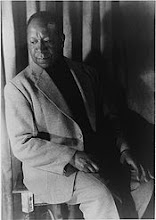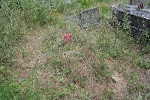Shortly after having published the post entitled “Two Street Scenes,” I received a message from Stephen Wicks, Barbara W. and Bernard E. Bernstein Curator at the Knoxville Museum of Art (KMA)—owner of the largest and most comprehensive public collection of Beauford Delaney’s work.
Wicks wrote to inform me about several Beauford Delaney works on paper in the museum’s collection that provide insight into the geographical location depicted in the magnificent yellow painting of a street scene that is currently being displayed at the Paris Noir exhibition in Paris.
He graciously shared his observations and supporting images from the KMA’s Beauford Delaney collection and the University of Tennessee Library’s Beauford Delaney Papers in the article below.
Beauford Delaney’s Street Scene (1968): An Expanded View
By Stephen Wicks
Monique Wells’ post, “Two Street Scenes,” provided a welcome opportunity to share some images and information concerning a group of related urban landscapes that Beauford Delaney created on two continents over a period of three decades.
Monique reconsidered her initial assessment that the Paris-era Street Scene (1968), sold by Phillips in December 2020, represents the City of Light after she saw the strikingly similar mid-1940s canvas called Untitled (Greenwich Village Street), which was sold at Swann Auction Galleries on October 3, 2024 from the collection of Delaney’s friend, Kenneth Lash.
(1968) Oil on canvas
Signed and dated "BEAUFORD DELANEY 1968" lower right
© Estate of Beauford Delaney,
by permission of Derek L. Spratley, Esquire,
Court Appointed Administrator
Courtesy of Michael Rosenfeld Gallery LLC, New York, N. Y.
(circa 1945-46) Oil on linen canvas
457x546 mm; 18x21½ inches.
Signed and dated (indistinctly) in oil, lower right recto.
Signed (three times) and inscribed "181 Greene St" (twice)"
and "NY" in oil on the stretcher bars, verso.
© Estate of Beauford Delaney
by permission of Derek L. Spratley, Esquire,
Court Appointed Administrator
While Delaney’s inventive studio approach often leaves the interpretation of subject and location open to multiple possibilities, considerable evidence supports the notion that these and other related scenes by the artist indeed depict elevated train tracks in New York City. They may represent a location not far from Delaney’s 181 Greene Street studio in Greenwich Village, which he occupied from 1936 to 1952.
First, Swann’s description of the painting indicates that inscribed on the back are "NY” and “181 Greene St.”
Second, related studies in a variety of media can be found in the artist’s New York-era sketchbooks; the time span they cover (mid 1940s-1967) and their number attest to the fact that this was a New York City scene of enduring interest to the painter.
Some studies take the form of pencil contour drawings.
Untitled (El study), circa 1940
Graphite on spiral sketchbook paper, approximately 4 x 6 inches
Beauford Delaney Papers, MS.3967,
Betsey B. Creekmore Special
Collections and University Archives,
University of Tennessee, Knoxville
© The Estate of Beauford Delaney
by permission of Derek L. Spratley, Esquire,
Court Appointed Administrator
Others are pastels or gouaches on spiral notebook paper that feature luminous environments punctuated by loose marks suggesting a fire hydrant or pedestrian.
Pastel on spiral notebook paper, approximately 4 x 6 inches
Knoxville Museum of Art, 2018 Beauford Delaney Acquisition
© The Estate of Beauford Delaney
by permission of Derek L. Spratley, Esquire,
Court Appointed Administrator
Pastel on spiral notebook paper, approximately 4 x 6 inches
Knoxville Museum of Art, 2018 Beauford Delaney Acquisition
© The Estate of Beauford Delaney
by permission of Derek L. Spratley, Esquire,
Court Appointed Administrator
Watercolor and gouache on spiral notebook paper, 4 1/8 x 7 inches
Knoxville Museum of Art, 2014 purchase with funds provided by
the Rachael Patterson Young Art Acquisition Reserve
© The Estate of Beauford Delaney
by permission of Derek L. Spratley, Esquire,
Court Appointed Administrator
Third, I discovered in one of Delaney’s albums a black and white photograph from the artist’s New York era depicting the canvas sold in 2024 by Swann. It is accompanied by an inscription identifying the title of the painting as “Third Avenue” and “owned by Mr. Kenneth Lash, University of New Mexico.”
Photograph of Delaney painting Third Avenue
identical to Untitled (Greenwich Village Street)
Beauford Delaney Papers, MS.3967,
Betsey B. Creekmore Special Collections and University Archives,
University of Tennessee, Knoxville
© The Estate of Beauford Delaney
by permission of Derek L. Spratley, Esquire,
Court Appointed Administrator
Detail: inscription for photograph of Third Avenue:
“Third Avenue, owned by Mr. Kenneth Lash, University of New Mexico”
With this information in hand, I consulted period photographs of elevated passenger train tracks along Third Avenue. I found that the Third Avenue El (demolished in 1954) ran roughly two blocks east of Delaney’s Greene Street studio, and that both canvases in question are likely based on views of the Third Avenue El from a nearby intersection. Perhaps the artist was aware that the city’s elevated tracks were being phased out in the 1940s-50s and was inspired to pay tribute.
which passed roughly two blocks east of Delaney’s
181 Greene Street studio.
Photograph by Sid Kaplan.
This array of evidence confirms Street Scene (1968) as a New York cityscape Delaney created some fifteen years after moving to Paris that evolved compositionally and chromatically over the course of several sketchbook studies. Perhaps the painter created Street Scene from memory, or perhaps he consulted the black and white photograph of his canvas Third Avenue as a visual reference.
In any case, Delaney’s decision to depict this Manhattan setting decades after moving to Paris attests to his enduring fascination with New York City’s urban landscape, and with this particular location.
Beauford Delaney Papers, MS.3967,
Betsey B. Creekmore Special Collections and University Archives,
University of Tennessee, Knoxville
© The Estate of Beauford Delaney
by permission of Derek L. Spratley, Esquire,
Court Appointed Administrator
Coincidentally or not, Beauford Delaney’s interest in this particular urban setting represents a fascinating point of intersection with the studio practice of his New York-based younger brother Joseph Delaney (1904-1991), who specialized in bold figurative paintings and drawings that capture the ebb and flow of urban life along New York City's bridges and boulevards.
But that’s another story for another day.














No comments:
Post a Comment